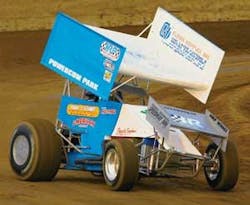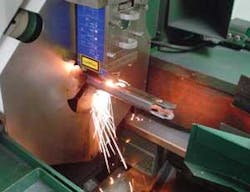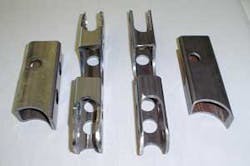Automated laser tube cutting speeds work and play
John Harris
Innovation and a solid work ethic have put Glenn Hepfner’s businesses in the winner’s circle more than once. Whether it is one of the family businesses-which include Glen Hepfner Inc. and Hepfner Racing Products-or a day at local racetrack Powercom Park, the Hepfner family will have a strategy that includes years of experience and the willingness to try something new in order to maintain their competitive edge.
Glenn Hepfner Inc. (GHI; Hartford, WI) was started as a metal fabricating business in the early 1970s and started laser cutting in 1992. Glenn and his sons Troy and Todd’s interest in racing led to Hepfner Racing Products (HRP) in the early 1990s and a controlling ownership in the raceway at Powercom Park in the year 2000. A good part of the credit for growing these successful businesses is their ability to identify and become early adopters of the latest in what technology has to offer.
Because tube fabrication technology had been slow to advance since the introduction of CNC machining centers 30 years ago, Hepfner and his sons decided there had to be a better way to fabricate metal tubular components. Mechanically produced tubes can take up to six different steps before the parts are ready for bending, welding, or paint. These may include sawing, punching, drilling, notching, machining, and deburring. The resulting parts suffered from the inherent build up of tolerances that each handling adds.
In 1996 GHI purchased a flat sheet laser machine that had a rotary axis that could also cut tubes. The company wanted to improve its production of HRP chassis parts but soon found out that there was a growing interest in the added job shop capability that laser tube cutting offered. With the new capability to cut tubes manually GHI quickly found work for this added capability.
As the company continued to grow both the racecar parts and job shop businesses it became apparent that it needed equipment that did not have the delicate set up or material waste that the manually loaded rotary machine required. GHI decided to investigate automated laser tube cutting.
In spring of 2004, after looking at all the alternatives, the Hepfner team decided that one of the BLM Group’s automated laser tube cutting machines, the Adige LT702D, was the most productive for its parts and therefore the right fit. The company understood this machine could increase production speed without having to “mess with the tube to get good parts, no more shimming.” The timing of the purchase was such that GHI could have the automated tube cutter installed in its new 80,000-square-foot facility in Hartford when it opened in July 2004.
The Adige machine can process 21-ft-long tubes up to 6-in OD, a capacity that fits 95 percent of the tube work GHI and HRP are doing. Up to 8800 lbs. of tubes- separated, measured, and loaded automatically-are cut with any shape or number of openings in the sidewall and then finished cut to length with any profile shape in the tube ends. The direct labor savings has been significant, up to 75 percent faster than the traditional methods, and operators are now free to do secondary operations such as bending or tapping or to get material ready for the next job.
The impact of the tube cutter was immediate. OEM race products are now being made much faster, with only a three-minute machine set up time between jobs.An example is an axel bracket set that was sawn to length, machined, and then deburred to produce 25 sets in approximately 11.5 hours. The manually loaded rotary axis laser machine improved production times to three hours of processing time, which still needed an additional 1.25 hours to saw the material to length first. The new laser system processes the 25 sets of parts in 45 minutes from mill length tubes and completely eliminates the sawing time-a 15-times improvement over the traditional machining method and 6-times improvement over manually loaded laser tube cutting.
Tubes can be programmed with as little as three inches of drop on a full-length tube, a 50 percent savings on many of the parts that were cut on the manually loaded tube laser, a savings that is pure profit. The company was quickly up to speed and finds it easier to maintain the quality its customers have come to expect. Also, the fast changeover capability of the machine gives it the flexibility to produce both large and small batches, keeping inventory levels lean.
While the Hepfners expected the system to increase the company’s OEM and job shop productivity, something interesting has happened to its job shop business. Word on the street has brought them a dozen new tube and flat sheet customers, with half supplying large repeat orders. The laser machine was originally going to be a one-shift operation, but with almost 6000 hours on the laser clock in a little over a year those plans changed. The company now runs a second shift and weekends unattended with an alarm set up to broadcast to them when the loader has run out of material. They have been pleasantly surprised with the machine running a lot more than originally planned.
The LT702D automated laser tube cutting machine brought Glenn Hepfner Inc. more than a faster and more efficient way to process straight tubes. It has been an unintentional new business generator. While taking care of new and current customers may have put a crimp on their racing schedule, the joy of going fast at work or play is something that the Hepfners will never tire of.
John Harris ([email protected]) is a sales engineer with BLM Group USA Corp. Wixom, MI (www.blmgroup.com).


